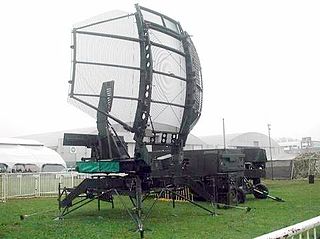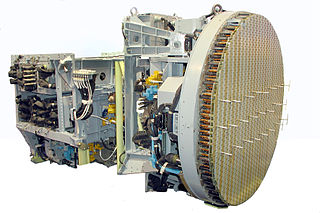
In antenna theory, a phased array usually means an electronically scanned array, a computer-controlled array of antennas which creates a beam of radio waves that can be electronically steered to point in different directions without moving the antennas.

An active electronically scanned array (AESA) is a type of phased array antenna, which is a computer-controlled array antenna in which the beam of radio waves can be electronically steered to point in different directions without moving the antenna. In the AESA, each antenna element is connected to a small solid-state transmit/receive module (TRM) under the control of a computer, which performs the functions of a transmitter and/or receiver for the antenna. This contrasts with a passive electronically scanned array (PESA), in which all the antenna elements are connected to a single transmitter and/or receiver through phase shifters under the control of the computer. AESA's main use is in radar, and these are known as active phased array radar (APAR).

A fire-control radar (FCR) is a radar that is designed specifically to provide information to a fire-control system in order to direct weapons such that they hit a target. They are sometimes known as narrow beam radars, targeting radars, or in the UK, gun-laying radars. If the radar is used to guide a missile, it is often known as a target illuminator or illuminator radar.

Rajendra is a passive electronically scanned array radar developed by the Defence Research and Development Organisation (DRDO). It is a multifunction radar, capable of surveillance, tracking and engaging low radar cross section targets. It is a ground surveillance radar and is a great source of surveillance operating at frequency around 20 GHz. It is mainly used to track enemy's installations.

The AN/MPQ-64 Sentinel is an X-band electronically steered pulse-Doppler 3D radar system used to alert and cue Short Range Air Defense (SHORAD) weapons to the locations of hostile targets approaching their front line forces. It is currently produced by Raytheon Missiles & Defense.

The S-75 is a Soviet-designed, high-altitude air defence system. It is built around a surface-to-air missile with command guidance. Following its first deployment in 1957 it became one of the most widely deployed air defence systems in history. It scored the first destruction of an enemy aircraft by a surface-to-air missile, with the shooting down of a Taiwanese Martin RB-57D Canberra over China on 7 October 1959 that was hit by a salvo of three V-750 (1D) missiles at an altitude of 20 km (65,600 ft). This success was credited to Chinese fighter aircraft at the time to keep the S-75 program secret.

Conical scanning is a system used in early radar units to improve their accuracy, as well as making it easier to steer the antenna properly to point at a target. Conical scanning is similar in concept to the earlier lobe switching concept used on some of the earliest radars, and many examples of lobe switching sets were modified in the field to conical scanning during World War II, notably the German Würzburg radar. Antenna guidance can be made entirely automatic, as in the American SCR-584. Potential failure modes and susceptibility to deception jamming led to the replacement of conical scan systems with monopulse radar sets. They are still used by the Deep Space Network for maintaining communications links to space probes. The spin-stabilized Pioneer 10 and Pioneer 11 probes used onboard conical scanning maneuvers to track Earth in its orbit.
Monopulse radar is a radar system that uses additional encoding of the radio signal to provide accurate directional information. The name refers to its ability to extract range and direction from a single signal pulse.

An airport surveillance radar (ASR) is a radar system used at airports to detect and display the presence and position of aircraft in the terminal area, the airspace around airports. It is the main air traffic control system for the airspace around airports. At large airports it typically controls traffic within a radius of 60 miles (96 km) of the airport below an elevation of 25,000 feet. The sophisticated systems at large airports consist of two different radar systems, the primary and secondary surveillance radar. The primary radar typically consists of a large rotating parabolic antenna dish that sweeps a vertical fan-shaped beam of microwaves around the airspace surrounding the airport. It detects the position and range of aircraft by microwaves reflected back to the antenna from the aircraft's surface. The secondary surveillance radar consists of a second rotating antenna, often mounted on the primary antenna, which interrogates the transponders of aircraft, which transmits a radio signal back containing the aircraft's identification, barometric altitude, and an emergency status code, which is displayed on the radar screen next to the return from the primary radar.

The AN/TPS-43 is a transportable air search 3D radar produced in the United States originally by Westinghouse Defense and Electronic Division, which was later purchased by Northrop-Grumman. It is used primarily for early warning and tactical control, often for control over an associated surface-to-air missile battery or airfield. It is designed to be transported in two M35 cargo trucks and easily air-transportable on two pallets.

The AN/SPG-55 was an American tracking / illumination radar for Terrier and RIM-67 Standard missiles (SM-1ER/SM-2ER). It was used for target tracking and surface-to-air missile guidance as part of the Mk 76 missile fire control system. It was controlled by a UNIVAC 1218 computer.

The Saab Giraffe Radar is a family of land and naval two- or three-dimensional G/H-band passive electronically scanned array radar-based surveillance and air defense command and control systems. It is tailored for operations with medium- and Short Range Air Defense (SHORAD) missile or gun systems, or for use as gap-fillers in a larger air defense system.

The Zhuk are a family of Russian all-weather multimode airborne radars developed by NIIR Phazotron for multi-role combat aircraft such as the MiG-29 and the Su-27. The PESA versions were also known as the Sokol.

The Bars (Leopard) is a family of Russian all-weather multimode airborne radars developed by the Tikhomirov Scientific Research Institute of Instrument Design for multi-role combat aircraft such as the Su-27 and the MiG-29.

The Russian BRLS-8B "Zaslon" (Barrier) is an all-weather multimode airborne radar developed between 1975 and 1980 by the Tikhomirov Scientific Research Institute of Instrument Design as part of the weapons control system of the MiG-31 supersonic interceptor. The NATO reporting name for the radar is Flash Dance with the designations "SBI-16", "RP-31", "N007" and "S-800" also being associated with the radar.
The KLJ-7, also referred to as the Type 1478, is an X band airborne fire-control radar (FCR) developed by Nanjing Research Institute of Electronic Technology (NRIET), also known as the China Electronics Technology Company's (CETC's) No. 14 Research Institute. In December 2010, Pakistan Air Force's Air Chief Marshal Rao Qamar Suleman announced that KLJ-7 radar will be built at Pakistan Aeronautical Complex (PAC), in Kamra, north of Islamabad.
The track while scan (TWS) is a mode of radar operation in which the radar allocates part of its power to tracking the target or targets while part of its power is allocated to scanning, unlike the straight tracking mode, when the radar directs all its power to tracking the acquired targets. In the TWS mode the radar has a possibility to acquire additional targets as well as providing an overall view of the airspace and helping maintain better situational awareness.

The P-30"Khrustal" also referred to by the NATO reporting name "Big Mesh" in the west is a 2D E band/F band radar developed and operated by the former Soviet Union.

Irbis-E is a Russian multi-mode, hybrid passive electronically scanned array radar system developed by Tikhomirov NIIP for the Sukhoi Su-35 multi-purpose fighter aircraft. NIIP developed the Irbis-E radar from the N011M Bars radar system used on Sukhoi Su-30MKI aircraft.
The AN/APY-10 is an American multifunction radar developed for the U.S. Navy's Boeing P-8 Poseidon maritime patrol and surveillance aircraft. AN/APY-10 is the latest descendant of a radar family originally developed by Texas Instruments, and now Raytheon after it acquired the radar business of TI, for Lockheed P-3 Orion, the predecessor of P-8.
















